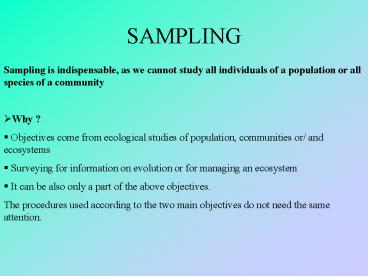SAMPLING - PowerPoint PPT Presentation
1 / 12
Title:
SAMPLING
Description:
Objectives come from ecological studies of population, communities or/ and ... cent confidence limits for the limpet Ancylus fluviatilis (Edwards et al, 1975) ... – PowerPoint PPT presentation
Number of Views:67
Avg rating:3.0/5.0
Title: SAMPLING
1
SAMPLING
- Sampling is indispensable, as we cannot study all
individuals of a population or all species of a
community - Why ?
- Objectives come from ecological studies of
population, communities or/ and ecosystems - Surveying for information on evolution or for
managing an ecosystem - It can be also only a part of the above
objectives. - The procedures used according to the two main
objectives do not need the same attention.
2
Where? / How long?
- Where ?
- As the objective is to have biotic data on flora
or fauna of a biotope, we must well define the
biotope. We must choose an apparently homogenous
place . - But for the mean level Homo sapiens as us an
'homogenous' biotope is in fact 'heterogeneous'.
If our objective is surveying an ecosystem then
the definition of the biotope is easy and
expectable. If the objective is studying
scientifically an ecosystem we must be very
careful with all the surrounding biotopes because
of ecotone effect. - How long ?
- For surveying, according to the speed of changegt
- For studying, according with cycles of seasons
(e.g. in temperate countries), life cycles of
species
3
Sampling methods
There are several methods. Each of them has
advantage and disadvantages. The choose of the
method is linked the objective and also the
facilities we dispose. Advantages
(disadvantages opposite) ? Great
representativity of samples in relation to the
whole population or community (non selective) ?
Meaningful data ? Short cost of time ? The least
possible of destruction to species or the
biotope ? Cost effective
4
Ecotone effect
number of species
?
?
?
A B C D
A B b c D
5
Samplers
- Sorbers, cylinders
- Quantitative results possible for benthic
organisms - Hand nets
- Qualitative results
- Drift nets
- Quantitative results on floating organisms
(possibly according to the depth). - Emergence nets
- Quantitative results on emergence fauna from
aquatic larva.
6
Quantitative samplers
a.Sorber b.Cylinder c. Ekman d. Corer
7
Artificial substrates
8
Representativity
- Preliminary results are needed in order to decide
the number of samples. This is linked to the type
of result we expect (e.g. number of species) - If a conventional statistical analysis is needed
then quantitative or semi-quantitative results
must be taken in a random way. In such a case one
sample is insufficient and the number of samples
must not defined.
9
Relation area number of species catches
Total number of species
max number 100
80
?
?
Modelised curve (logarithmic system)
?
Area
s2
experimental data
10
Extensive or Intensive Surveys
Surveys may be either extensive or intensive.
Extensive surveys aim to discover what species
are present in an area, usually with a measure of
relative abundance, and are especially used where
the water quality over many sites is being
monitored or compared. Such surveys have been
criticized, or even considered valueless (e.g.
Gray, 1976), because they are too superficial to
detect or interpret subtle environmental changes,
such as alterations in species dominance due to
biological interactions (so that it is impossible
to disentangle natural changes from those caused
by pollution). Such a view is undoubtedly too
pessimistic and these surveys may detect natural
changes without a detailed foreknowledge of the
ecology of a site. It is probably true, however,
that sampling design is frequently given
inadequate thought in extensive surveys.
11
Intensive Surveys
Intensive surveys usually aim to determine
population densities. Populations of organisms
are usually highly aggregated so that a large
number of samples are frequently required to
obtain a population estimate that is
statistically meaningful. Chutter and Noble
(1966) and Chutter (1972), using benthic
macroinvertebrate data from streams in South
Africa and California, considered that over fifty
(50) replicates are required to attain an
estimate of population size to within 20 per
cent. For some species, many more samples would
be needed. Ninety-eight (98) samples were
required to obtain an estimate of mean density
(40 per cent), with 95 per cent confidence
limits for the limpet Ancylus fluviatilis
(Edwards et al, 1975). Such sampling intensity
would be impossible in an extensive survey and
even in an intensive survey the rarer species
will be inadequately sampled. Edwards et al
(1975) have shown that, sampling a riffle, only
44 per cent of the species taken would be common
to both of any two random samples. The number of
samples required for a specified degree of
precision can be readily calculated if an
estimate of the mean abundance is made from a
pilot survey.
12
Different types of results
- Data on communities help us to evaluate the
biodiversity. Indices are good tools for such
evaluations (see Daniel CDrom) richness,
Shannon index, Margalef index - Patrimonial index translates also the global
degree of rarity of species. - Data on population are good for the study of
evolution population, survival curves, - Data for surveying must be standardized in order
to assess evolution in ecosystems. - Abiotic factors are also needed in order to be
able to make comparisons with the biotic data.
The latter can be analysed by multivariate
analyses.
13
Indices- scores or other
- Saprobiotic
- Diversity indices
- e.g. IS(no of species) / N(total no of
individuals.) - but they may mislead us
- Biotic indices
- Multiparametric indices (Predictive models
leading to a biolic index, e.g. RIVPACKS)
14
Thank you very much for Angela to be present so
early in the morning































